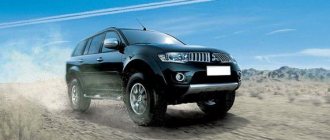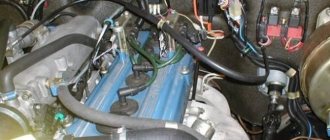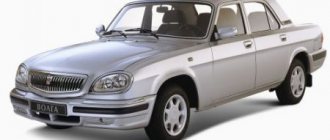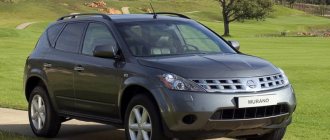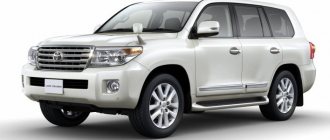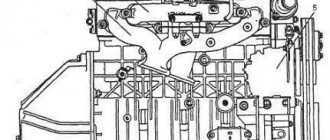Nissan launched Terrano production in 1993 and has already produced 6 generations and 48 modifications, with engine packages that support the environmental standards EURO IV, EURO V, EURO II, EURO III with volumes: 1598, 1998, 2388, 2389, 2663, 2953, 2960, 3274 cm3 and power: 99, 100, 102, 103, 114, 116, 118, 124, 125, 135, 143, 148, 154, 155, 170 l/s, using gasoline, diesel, grades as fuel AI-95, DT, AI-92, Gasoline, with gearbox: automatic, manual. Read the full description: Nissan Terrano on Wikipedia (official page). And the fuel consumption of Nissan (Nissan) Terrano in the mixed, urban (in the city) and suburban (on the highway) cycle ranges from 6.3 to 16 liters per 100 km, which, with a tank volume of 50, 72, 80 liters, allows you to travel a distance from 440 km. up to 1080 km.. In addition, in various modifications additional options were used that expand and improve the capabilities of the fuel system (generations are indicated in brackets including restyling to which this option applies):
- Service interval 1 year or 15,000 km for gasoline engines (1)
Fuel consumption per 100 km for Nissan Terrano (since 2014), Crossover, 5th generation
| Modification | Fuel consumption, l/100 km | Power reserve (km.) | ||
| highway | city | MIX | ||
| 1598 cm³, 102 hp, tank (50 l.) - AI-95, manual transmission, front-wheel drive | 6.5 | 9.8 | 7.6 | 510 — 770 |
| 1998 cm³, 135 hp, tank (50 l.) - AI-95, manual transmission, all-wheel drive | 6.5 | 10.3 | 7.8 | 490 — 770 |
| 1598 cm³, 102 hp, tank (50 l.) - AI-95, manual transmission, all-wheel drive | 7 | 11 | 8.2 | 450 — 710 |
| 1998 cm³, 135 hp, tank (50 l.) - AI-95, automatic transmission, front-wheel drive | 6.7 | 11 | 8.3 | 450 — 750 |
| 1598 cm³, 114 hp, tank (50 l.) - AI-95, manual transmission, front-wheel drive | 6.3 | 9.3 | 7.4 | 540 — 790 |
| 1598 cm³, 114 hp, tank (50 l.) - AI-95, manual transmission, all-wheel drive | 6.8 | 9.1 | 7.6 | 550 — 740 |
| 1998 cm³, 143 hp, tank (50 l.) - AI-95, manual transmission, all-wheel drive | 6.4 | 10.1 | 7.8 | 500 — 780 |
| 1998 cm³, 143 hp, tank (50 l.) - AI-95, automatic transmission, all-wheel drive | 7.2 | 11.3 | 8.7 | 440 — 690 |
Fuel consumption Nissan Terrano
The table contains official data on fuel consumption of Nissan Terrano with gasoline engines: 1.6 (K4M), 1.6 (H4M) and 2.0 (F4R).
| Volume, engine, fuel | Drive, gearbox | In the city | On the road | Mixed |
| 1.6 K4M | 2WD 5 manual transmission | 9,8 | 6,5 | 7,6 |
| 4WD 6 manual transmission | 11 | 7 | 8 | |
| 1.6 N4M | 2WD 5 manual transmission | 9,3 | 6,3 | 7,4 |
| 4WD 6 manual transmission | 9,1 | 6,8 | 7,6 | |
| 2.0 F4R | 4WD 6 manual transmission | 10,3 | 6,5 | 7,8 |
| 2WD 4automatic | 11 | 6,7 | 8,3 | |
| 4WD 4automatic | 11,3 | 7,2 | 8,7 |
Fuel consumption per 100 km for Nissan Terrano (1993 - 2002), SUV, R20
| Modification | Fuel consumption, l/100 km | Power reserve (km.) | ||
| highway | city | MIX | ||
| 2663 cm³, 100 hp, tank (72 l.) - diesel engine, manual transmission, all-wheel drive | — | — | 10.9 | up to 661 |
| 2663 cm³, 100 hp, tank (80 l.) - diesel engine, manual transmission, all-wheel drive | — | — | 11.2 | up to 714 |
| 2389 cm³, 124 hp, tank (72 l.) - AI-95, manual transmission, all-wheel drive | — | — | 11.1 | up to 649 |
| 2389 cm³, 124 hp, tank (80 l.) - AI-95, manual transmission, all-wheel drive | — | — | 11.4 | up to 702 |
"Nissan-Terrano": real fuel consumption in different modes
The base 1.6-liter engine with a five-speed manual transmission will require no more than 7.6 liters of fuel in mixed mode. In the urban cycle, consumption will increase and amount to about 11 liters. In winter, the crossover will require approximately 1-2 liters of fuel more than stated by the manufacturer. When driving on the highway, the Terrano will be limited to 5.8 liters per 100 kilometers.
In a two-liter Nissan Terrano, fuel consumption per 100 km will be about 8.3 liters in mixed mode. On the highway the car will require no more than 6.1 liters, and in the city - 11.2.
If low-quality fuel is used, the total consumption may vary significantly. Also, when moving, unpleasant jerking and twitching will appear.
Fuel consumption per 100 km for Nissan Terrano, SUV, WD21
| Modification | Fuel consumption, l/100 km | Power reserve (km.) | ||
| highway | city | MIX | ||
| 2960 cm³, 155 hp, tank (80 l.) - AI-92, manual transmission, all-wheel drive | — | 12.5 | — | 640 |
| 2960 cm³, 155 hp, tank (80 l.) - AI-92, automatic transmission, all-wheel drive | — | 13.6 | — | 590 |
| 2388 cm³, 103 hp, tank (80 l.) - AI-92, manual transmission, all-wheel drive | 9.6 | 16 | 12.5 | 500 — 830 |
| 2663 cm³, 99 hp, tank (80 l.) - diesel engine, manual transmission, all-wheel drive | 8 | 12 | 10.3 | 670 — 1000 |
| 2960 cm³, 155 hp, tank (80 l.) - AI-92, automatic transmission, all-wheel drive | — | 15.1 | — | 530 |
| 2960 cm³, 155 hp, tank (80 l.) - AI-92, automatic transmission, all-wheel drive | — | 15.1 | — | 530 |
| 2960 cm³, 155 hp, tank (80 l.) - AI-92, automatic transmission, all-wheel drive | — | 13.6 | — | 590 |
| 2960 cm³, 155 hp, tank (80 l.) - AI-92, automatic transmission, all-wheel drive | — | 13.6 | — | 590 |
| 2960 cm³, 155 hp, tank (80 l.) - AI-92, manual transmission, all-wheel drive | — | 12.5 | — | 640 |
| 2960 cm³, 148 hp, tank (80 l.) - AI-92, manual transmission, all-wheel drive | 10.6 | 15.4 | 14.3 | 520 — 750 |
| 2960 cm³, 155 hp, tank (80 l.) - AI-92, manual transmission, all-wheel drive | — | 13.5 | — | 590 |
| 2960 cm³, 155 hp, tank (80 l.) - AI-92, manual transmission, all-wheel drive | — | 12.5 | — | 640 |
| 2960 cm³, 155 hp, tank (80 l.) - AI-92, automatic transmission, all-wheel drive | — | 13.6 | — | 590 |
| 2960 cm³, 155 hp, tank (80 l.) - AI-92, automatic transmission, all-wheel drive | — | 15.1 | — | 530 |
| 2960 cm³, 148 hp, tank (80 l.) - AI-92, automatic transmission, all-wheel drive | 10.6 | 15.4 | 14.3 | 520 — 750 |
| 2960 cm³, 148 hp, tank (80 l.) - AI-92, manual transmission, all-wheel drive | 10.6 | 15.4 | 14.3 | 520 — 750 |
| 2960 cm³, 155 hp, tank (80 l.) - AI-92, manual transmission, all-wheel drive | — | 13.5 | — | 590 |
| 2960 cm³, 155 hp, tank (80 l.) - AI-92, manual transmission, all-wheel drive | — | 12.5 | — | 640 |
Nissan Terrano details about fuel consumption
The new Nissan Torrano model was demonstrated to car enthusiasts in 1988. Since then, the car has enjoyed continued popularity and has a whole army of followers. Such characteristics as economical fuel consumption on the Nissan Torrano, high maneuverability and maneuverability, reliability and durability, allow the car to remain the sales leader in the Nissan line for many years.
Car modifications
The car was restyled several times, but the basic principles remained unchanged, as did the desire of manufacturers to reduce fuel costs. Two generations of SUVs of this brand and more than ten different modifications were produced.
1.6 (gasoline) 6-mech, 4x4
2.0 (petrol) 6-mech, 4×4
2.0 (petrol) 4-var Xtronic CVT
1.6 manual transmission
The first and most budget model of the car was equipped with a 103 horsepower engine and a manual transmission. Acceleration time to 100 mph was 11 seconds. Two configuration options were presented: with part-time drive and all-wheel drive modification. The average fuel consumption of the Nissan Terrano per 100 km largely depended on this.
The data indicated by the manufacturer based on owner reviews practically coincides with real indicators and amounts to
:
- fuel consumption on a Nissan Terrano in the city is 6.6 liters;
- on the highway - 5.5 l;
- in a mixed cycle - 6 liters.
2.0 automatic transmission
From 1988 to 1993, a car was produced equipped with a 2.0 power unit with a capacity of 130 horsepower. Gasoline consumption rates for the Nissan Terrano have increased slightly, but:
- fuel costs for the Terrano when driving within the city were 6.8 liters per 100 km;
- when driving on the highway - 5.8 l;
- in the combined cycle - 6.2 liters.
The model was preferred by lovers of a quiet ride as a comfortable family car.
With each update, the technical characteristics of the car improved, interior comfort increased, while the developers managed to keep fuel consumption on the Terrano at fairly low figures, as for a car of this class.
The latest update of 2021 affected, first of all, the interior of the cabin, and the trunk volume has increased. Nissan developers retained front-wheel drive and a 5-speed manual transmission. The actual fuel consumption for the 2021 Nissan Terrano is as follows.
:
- urban cycle - 9.3 l;
- Nissan Terrano's gasoline consumption on the highway is 6.3 liters;
- mixed cycle -7.8l.
How to reduce fuel consumption
Gasoline consumption on a Nissan Terrano depends on many factors. For example, fuel consumption rates will be higher in the cold season due to additional fuel costs for additional engine warming and interior heating.
Fuel consumption per 100 km for Nissan Terrano, SUV, R50
| Modification | Fuel consumption, l/100 km | Power reserve (km.) | ||
| highway | city | MIX | ||
| 3274 cm³, 170 hp, tank (80 l.) - Gasoline, automatic transmission, front-wheel drive | — | 13.1 | — | 610 |
| 3274 cm³, 170 hp, tank (80 l.) - Gasoline, automatic transmission, all-wheel drive | — | 13.8 | — | 580 |
| 3274 cm³, 170 hp, tank (80 l.) - Gasoline, automatic transmission, all-wheel drive | — | 13.8 | — | 580 |
| 3274 cm³, 170 hp, tank (80 l.) - Gasoline, automatic transmission, all-wheel drive | — | 13.8 | — | 580 |
| 3274 cm³, 170 hp, tank (80 l.) - Gasoline, automatic transmission, all-wheel drive | — | 13.8 | — | 580 |
| 3274 cm³, 170 hp, tank (80 l.) - Gasoline, automatic transmission, all-wheel drive | — | 13.8 | — | 580 |
Russia
Fuel consumption Nissan Terrano 2014, jeep/suv 5 doors, 3rd generation
| Engine capacity | Power | Transmission | Drive unit | Fuel | Consumption |
| 1.6 l | 114 hp | Manual transmission | front-wheel drive | Petrol | 7,4 |
| 1.6 l | 114 hp | Manual transmission | four-wheel drive (4WD) | Petrol | 7,6 |
| 1.6 l | 102 hp | Manual transmission | front-wheel drive | Petrol | 7,6 |
| 2.0 l | 143 hp | Manual transmission | four-wheel drive (4WD) | Petrol | 7,8 |
| 2.0 l | 135 hp | Manual transmission | four-wheel drive (4WD) | Petrol | 7,8 |
| 1.6 l | 102 hp | Manual transmission | four-wheel drive (4WD) | Petrol | 8,2 |
| 2.0 l | 135 hp | Automatic transmission | front-wheel drive | Petrol | 8,3 |
| 2.0 l | 143 hp | Automatic transmission | four-wheel drive (4WD) | Petrol | 8,7 |
Fuel consumption per 100 km for Nissan Terrano, SUV, R20 [2nd restyling]
| Modification | Fuel consumption, l/100 km | Power reserve (km.) | ||
| highway | city | MIX | ||
| 2389 cm³, 118 hp, tank (80 l.) - AI-95, manual transmission, all-wheel drive | — | — | 11.4 | up to 702 |
| 2663 cm³, 125 hp, tank (80 l.) - diesel engine, manual transmission, all-wheel drive | 8 | 11 | 10.2 | 730 — 1000 |
| 2953 cm³, 154 hp, tank (80 l.) - diesel engine, automatic transmission, all-wheel drive | 8.2 | 12.7 | 9.8 | 630 — 980 |
| 2953 cm³, 154 hp, tank (80 l.) - diesel engine, manual transmission, all-wheel drive | 7.4 | 11.3 | 8.8 | 710 — 1080 |
| 2389 cm³, 116 hp, tank (72 l.) - AI-95, manual transmission, all-wheel drive | — | — | 11.1 | up to 649 |
| 2663 cm³, 125 hp, tank (72 l.) - diesel engine, manual transmission, all-wheel drive | 8 | 11 | 10.2 | 650 — 900 |
| 2953 cm³, 154 hp, tank (72 l.) - diesel engine, automatic transmission, all-wheel drive | 8.2 | 12.7 | 9.8 | 570 — 880 |
| 2953 cm³, 154 hp, tank (72 l.) - diesel engine, manual transmission, all-wheel drive | 7.4 | 11 | 8.8 | 650 — 970 |
Official data (l/100 km)
| Engine | Consumption (city) | Consumption (highway) | Flow (mixed) |
| 1.6 MT petrol (manual) | 9.3 | 6.3 | 7.4 |
| 2.0 MT petrol (manual) | 10.1 | 6.4 | 7.8 |
| 2.4 MT petrol (manual) | 15.8 | 10.3 | 12.9 |
| 2.7 MT diesel (manual) | 11.9 | 8.7 | 10.0 |
| 2.7 AT diesel (automatic) | 13.1 | 9.3 | 11.9 |
| 3.0 MT diesel (manual) | 11.3 | 7.4 | 8.8 |
| 3.0 AT diesel (automatic) | 12.7 | 8.2 | 9.8 |
Fuel consumption per 100 km for Nissan Terrano, SUV, R20 [restyling]
| Modification | Fuel consumption, l/100 km | Power reserve (km.) | ||
| highway | city | MIX | ||
| 2389 cm³, 116 hp, tank (72 l.) - AI-95, manual transmission, all-wheel drive | — | — | 11.1 | up to 649 |
| 2663 cm³, 125 hp, tank (72 l.) - diesel engine, manual transmission, all-wheel drive | 8 | 11 | 10.2 | 650 — 900 |
| 2389 cm³, 118 hp, tank (80 l.) - AI-95, manual transmission, all-wheel drive | — | — | 11.4 | up to 702 |
| 2663 cm³, 125 hp, tank (80 l.) - diesel engine, manual transmission, all-wheel drive | 8 | 11 | 10.2 | 730 — 1000 |
Specifications
The Japanese offer two types of engine to choose from:
- 1.6 liter unit with 16 valves and a maximum power of 102 “horses”;
- 2.0-liter engine with 135 horsepower.
Both units run on AI-95 gasoline; diesel versions are not offered. The fuel consumption of the Nissan-Terrano 2.0 in the all-wheel drive version does not go beyond 8.3 liters in mixed mode.
Additional characteristics:
- length – 4341 mm;
- width – 1823 mm;
- height – 1669 mm;
- ground clearance – 210 mm;
- Fuel tank capacity – 50 l.
All versions are equipped with a full-size spare wheel and a five-liter reservoir for windshield washer fluid.
Nissan Terrano 1.6, 2.0, 2.4 fuel consumption per 100 km according to reviews
Nissan Terrano is a spectacular SUV from Japanese manufacturers, which has been in high demand among domestic car enthusiasts for many years.
The model under this name is one of the Japanese long-livers. Nissan Terrano 1 appeared back in 1986, which were originally produced under a slightly different, more recognizable name by many - Nissan Pathfinder. The model lasted for eight years. The second generation - Nissan Terrano 2 - was released in 1993. The latest and most modern version of this car brand has become available to customers since 2013.
Considering the great love of domestic car enthusiasts for Japanese cars, including SUVs, it is not surprising that this particular brand is very popular in Russia to this day. Naturally, before purchasing such a vehicle, it is important to find out the real fuel consumption of the chosen model, since often the official characteristics do not coincide at all with the result shown by the car being used in reality.
Nissan Terrano fuel consumption
If you run out of propane, then the pan is lost on the road
This car was first introduced back in 1985. But it was called Nissan Terrano only until 2004. After this, the model was renamed Nissan Pathfinder. The previous name was given to a completely different car, which was assembled on the basis of Renault Duster. After that, the car changed its class to a full-size SUV.
Official data (l/100 km)
| Engine | Consumption (city) | Consumption (highway) | Flow (mixed) |
| 1.6 MT petrol (manual) | 9.3 | 6.3 | 7.4 |
| 2.0 MT petrol (manual) | 10.1 | 6.4 | 7.8 |
| 2.4 MT petrol (manual) | 15.8 | 10.3 | 12.9 |
| 2.7 MT diesel (manual) | 11.9 | 8.7 | 10.0 |
| 2.7 AT diesel (automatic) | 13.1 | 9.3 | 11.9 |
| 3.0 MT diesel (manual) | 11.3 | 7.4 | 8.8 |
| 3.0 AT diesel (automatic) | 12.7 | 8.2 | 9.8 |
1st generation
Several engines were installed on the first generation Nissan Terrano. One of them was a 2.7 liter diesel engine that produced power up to 100 horsepower. It could be paired with either a manual five-speed gearbox or a robotic four-speed one. Fuel consumption per 100 km was 10.3 liters. There were two petrol representatives: 2.4 and 3.0 liters.
The first could develop power of 103 or 124 horsepower. It was equipped with only mechanics, and its gas consumption was 12.1 liters. The second could already boast 149 or 155 horses, as well as both transmission options. Here the actual consumption reached 14.4 liters. All trim levels were equipped with only all-wheel drive.
2nd generation
In 1993, the second generation of a fairly successful SUV appeared on markets around the world. In addition to the obvious changes in design and equipment, there were new items in the choice of engine. The diesel 2.7 remained the same, only without the possibility of installing an automatic transmission. A 3.2-liter unit was added to it. Its power was 150 horsepower. But he was walking only with a machine gun. This engine consumed 11.4 liters of fuel. The gasoline range has also changed. The 2.4-liter unit was given a constant power of 124 horsepower. Everything else remains as it was before.
It was decided to abandon the three-liter installation. It was replaced by two new engines: 3.3 and 3.5 liters. The first one always produced 170 horsepower. It was driven only by an automatic transmission, but could have rear-wheel drive, and not all-wheel drive, like all other versions. Fuel consumption for this configuration was 14.9 liters. The second gasoline novelty developed a power of 241 horsepower. Here the buyer could already choose both transmissions, but the drive was only all-wheel drive. 15.7 liters of fuel were spent here.
In the first restyling in 1996, they decided not to touch anything technically, but in the second, which happened in 1999, the 3.2-liter diesel unit was replaced with a three-liter unit with a capacity of 154 horsepower. It came with both transmissions and only all-wheel drive. The engine consumed 9.6 liters of fuel.
“My biggest mistake was that I took the rear-wheel drive version. I wanted to use the car for trips into nature, but without all-wheel drive, as it turned out, there was nothing to do there at all. Yes, it can drive a lot of places, but it will take much more time than the all-wheel drive version. I'm happy with everything else, even the expense. I think it’s normal that 17 liters are wasted,” writes Valery from Smolensk.
“I bought the car because it cost a penny and was in good condition, and I just needed a new SUV. This Nissan turned out to be a worthy representative of this family. It overcomes any difficulties perfectly, although it consumes a lot of gasoline. My norm is 18 liters,” said Dmitry from Rostov.
“An excellent car for active recreation enthusiasts. You just need to take the all-wheel drive version so that off-roading is not a problem on the way to your desired vacation spot. The salon is very comfortable, functional and roomy. Five fairly large adults fit without any problems. The only problem is the high consumption. It comes out to 17 liters,” responded Mikhail from Omsk.
Nissan Terrano: fuel consumption per 100 km
Car owners are increasingly beginning to buy all-wheel drive cars. They allow you to feel confident on a country road, on a trip to the country, fishing, or hunting. Four-wheel drive can be useful even in a city yard if it is heavily covered with snow. Nissan offers the Terrano crossover, which feels great both in a populated area and on a gravel stretch on the way to your favorite lake.
Car history
At the beginning of 1980, Japanese engineers began to develop a new car on their own platform. The frame structure, continuous rear axle and reinforced transmission became the main and integral part of the first generation Terrano.
Initially it was planned to use the chassis from the Navara pickup. However, frequent modifications to the width and location of the units led to the creation of a design from scratch. This has resulted in improved driving characteristics, reduced weight and reduced chassis susceptibility to road potholes.
First generation Terrano (1986)
The first body number WD21 was presented at the end of the summer of 1986. At the start of sales, all configurations were 3-door with a powerful spar frame that was not afraid of corrosion and torsional loads.
A five-door variation was introduced in 1990 in the United States. What’s unusual is the fact that both versions are the same length – 4365 millimeters. All versions were equipped with all-wheel drive with a powerful transfer case and a continuous rear axle. The front axle was connected using levers installed in the cabin. The clutches built into the hubs responded with a delay and often required a slight rollback of the car to fully engage.
Part-time all-wheel drive is only permitted on roads with slippery or unpaved surfaces. “Terrano-1” was no exception to this rule; it was possible to move on the highway only with rear drive wheels.
The SUV’s suspension has long strokes and “swallows” holes and potholes on the roads quite well. The downside of such softness was the rolliness when cornering, which was not corrected even in the subsequent restyling.
There are several power plants available on the market:
- a gasoline unit with a power of 103 horsepower and a volume of 2.4 liters;
- 3.0-liter engine with single injection producing 130 hp. With.
Outdated technology for supplying fuel to the cylinders reduced the power of the Nissan Terrano 1. Fuel consumption in city driving mode reaches an obscene 24-26 liters per 100 km. On the highway with the front axle disabled, the 3.0-liter engine will require at least 12-14 hp.
The first-generation salon turned out to be in a classic style without frills in the form of a leather-trimmed dashboard or seats with electrical adjustments. All versions were equipped from the factory with power steering, air conditioning and a compass built into the center console.
Second generation Terrano (1993)
The second body did not depart from previous traditions and remained a brutal SUV with square shapes. Global changes affected the length of the car, roof height, chassis settings and power plants.
The second generation was developed jointly with. The chassis was based on the design from the popular Ford-Maverick, which ranked first in the compact SUV class in the United States. Belgian stylists led by Alain Blonnet worked on the design of the second generation Terrano.
Basic configurations were offered with power steering, a central locking system, electric mirrors and an audio system. The interior has become much more pleasant, with improved sound insulation and headroom for rear-row passengers. The maximum versions still lacked leather seats with electrically adjustable tilt angles.
The Nissan Terrano, whose fuel consumption was reduced thanks to new engines, became more confident in cornering and acquired a diesel unit. The following were offered to choose from:
- turbodiesel with a power of 99 horsepower and a volume of 2.7 liters;
- 2.0-liter engine with 124 horsepower and an injection system.
In the Nissan-Terrano, fuel consumption per 100 kilometers dropped from 25 liters in the city to an acceptable 16-19, depending on driving style. Gasoline and diesel units were paired with a mechanical transmission, which could withstand quite serious loads.
In 1999, Nissan introduced an improved model, which received a new grille, bumpers and headlights. Nice touches have been added to the interior in the form of cup holders and comfortable seat backs. The suspension has become more comfortable, this is influenced by new shock absorbers using oil and gas.
Modern Terrano
In 2014, Japanese engineers decided to relaunch the Terrano and began producing a compact crossover for emerging markets. The budget car is built on the Renault Duster platform and has nothing in common with the two previous generations.
The new Terrano has lost its frame structure, lost its honest all-wheel drive and acquired a modern appearance with rounded lines.
In the Nissan-Terrano, fuel consumption does not exceed 12 liters due to the lightweight body and reduced volume of power units.
Exterior
The appearance of the new crossover is practically no different from the Renault Duster. The almost horizontal line of the hood turns into large block headlights, which connect to the radiator grille, abundantly covered with chrome. In the center is a large Nissan nameplate, which is also decorated with shiny material. The front bumper is quite short, which has a positive effect on the approach angle. At the bottom there are fog lights and a protective cover made of silver plastic.
From the side, the crossover has not undergone any pronounced changes and is no different from the single-platform car from Renault. All the same large wheel arches with small wheels, a high glass line and roof rails, which are painted silver on the Terrano. You can recognize that it belongs to Nissan only by the central caps of alloy wheels.
The stern received more differences. The first thing that catches your eye is the new optics. The lampshades have noticeably expanded and extended onto the trunk lid. The shape of the bumper has also changed. It has built-in fog lights and sensors from the parking assistance system. Hanging over the exhaust pipe is durable protective plastic, which is painted gray and protects the bumper from minor damage.
Fuel consumption Nissan Terrano II 1996, jeep/suv 5 doors, 1st generation, R20
| Engine capacity | Power | Transmission | Drive unit | Fuel | Consumption |
| 2.7 l | 125 hp | Manual transmission | four-wheel drive (4WD) | Diesel fuel | 9,9 |
| 2.7 l | 125 hp | Automatic transmission | four-wheel drive (4WD) | Diesel fuel | 10,7 |
| 2.4 l | 118 hp | Manual transmission | four-wheel drive (4WD) | Gasoline AI-95 | 12,3 |
Fuel consumption of Nissan Terrano
Fuel consumption is a serious issue for car enthusiasts.
For wealthy people, it fades into the background. Most car owners either choose not too powerful cars, or are looking for ways to reduce consumption. Nissan Terrano offers a worthy alternative.
Comparison of the first and last models by internal combustion engine
The fuel consumption of the first Nissan Terrano (1986) or, under another name, Pathfinder, did not produce the most pleasant fuel indicators. The simplest internal combustion engine for it on gasoline with a volume of 2.4 liters “ate”:
- mixed route - 12.5 l;
- highway - 9.6 l;
- city - 16 l.
The diesel unit was also significantly within the budget:
- mixed route - 10.3l;
- track – 8 l;
- city - 12 l.
With each generation, the manufacturer qualitatively changed the power units. Fuel consumption gradually decreased. By the latest Terrano model from 2013, the situation has changed significantly. It is logical - technology does not stand still, and the issue of fuel economy is becoming more and more urgent. A configuration with two engines was introduced to the Russian market.
1. Volume – 1.6 l. power 102 l, gearbox – mechanics:
- mixed route - 7.6 l;
- highway - 6.5 l;
- city - 9.8 l.
2. Volume – 2.0 l. power 135 l, gearbox – manual/automatic:
- mixed route - 7.8 l/8.3 l;
- highway – 6.5 l/6.7 l;
- city - 10.3 l/11.6 l.
As can be seen from the indicators, the efficiency of the latest generation Nissan engines has increased significantly. However, these are the indications according to the manufacturer. Cars are tested under ideal conditions. The fuel consumption data presented is presented as predicted and averaged.
As practice has shown, the actual fuel consumption of these cars turned out to be even lower than declared. Why the car and the internal combustion engine performed so well is not entirely clear. One of the assumptions is savvy in terms of reducing fuel consumption.
How to save fuel on a Nissan Terrano
There are as many saving options as there are craftsmen. However, it is still possible to identify real ways to reduce gasoline and diesel consumption in any driving conditions:
- The engine should be warmed up after starting at medium shaft rotation.
- There is no need to make jerks or sudden braking, but move evenly. Move more often in 4th gear (in urban conditions it allows you to drive at a speed of 50 km/h with a savings of 25% than in 3rd). 5th gear saves 15% than 4th at a speed of 70-90 km/h. In addition, it is recommended to change gears on time.
- After just 1 minute of stopping, it is better to turn off the engine. 5 minutes. idling is about 1 km on the road.
- Drive at maximum speed less often (it is better to stick to ¾ of the maximum).
- Do not let the air pressure in the tires drop.
- All additional equipment (stove, air conditioner, window heaters, etc.) increase fuel consumption.
- The roof rack on most models increases air resistance, which increases fuel consumption.
Useful video
As a result, we can say that the latest generation Nissan Terrano has become one of the bestsellers. This was seriously affected by moderate fuel consumption on any trim level. The disadvantages include the fact that the model is not very suitable for off-road use, but that is another question.
Fuel consumption Nissan Terrano II restyling 1999, jeep/suv 5 doors, 1st generation, R20
| Engine capacity | Power | Transmission | Drive unit | Fuel | Consumption |
| 2.7 l | 125 hp | Manual transmission | four-wheel drive (4WD) | Diesel fuel | 9,9 |
| 2.7 l | 125 hp | Automatic transmission | four-wheel drive (4WD) | Diesel fuel | 10,7 |
| 2.4 l | 116 hp | Manual transmission | four-wheel drive (4WD) | Gasoline AI-95 | 12,3 |
Comparison of the first and last models by internal combustion engine
The fuel consumption of the first Nissan Terrano (1986) or, under another name, Pathfinder, did not produce the most pleasant fuel indicators. The simplest internal combustion engine for it on gasoline with a volume of 2.4 liters “ate”:
- mixed route - 12.5 l;
- highway - 9.6 l;
- city - 16 l.
The diesel unit was also significantly within the budget:
- mixed route - 10.3l;
- track – 8 l;
- city - 12 l.
With each generation, the manufacturer qualitatively changed the power units. Fuel consumption gradually decreased. By the latest Terrano model from 2013, the situation has changed significantly. It is logical - technology does not stand still, and the issue of fuel economy is becoming more and more urgent. A configuration with two engines was introduced to the Russian market.
1. Volume – 1.6 l. power 102 l, gearbox – mechanics:
- mixed route - 7.6 l;
- highway - 6.5 l;
- city - 9.8 l.
2. Volume – 2.0 l. power 135 l, gearbox – manual/automatic:
- mixed route - 7.8 l/8.3 l;
- highway – 6.5 l/6.7 l;
- city - 10.3 l/11.6 l.
As can be seen from the indicators, the efficiency of the latest generation Nissan engines has increased significantly. However, these are the indications according to the manufacturer. Cars are tested under ideal conditions. The fuel consumption data presented is presented as predicted and averaged.
As practice has shown, the actual fuel consumption of these cars turned out to be even lower than declared. Why the car and the internal combustion engine performed so well is not entirely clear. One of the assumptions is savvy in terms of reducing fuel consumption.
Fuel consumption Nissan Terrano II 1996, jeep/suv 3 doors, 1st generation, R20
| Engine capacity | Power | Transmission | Drive unit | Fuel | Consumption |
| 2.7 l | 125 hp | Manual transmission | four-wheel drive (4WD) | Diesel fuel | 9,8 |
| 2.7 l | 125 hp | Automatic transmission | four-wheel drive (4WD) | Diesel fuel | 10,6 |
| 2.4 l | 118 hp | Manual transmission | four-wheel drive (4WD) | Gasoline AI-95 | 11,9 |
Fuel consumption Nissan Terrano II restyling 1999, jeep/suv 3 doors, 1st generation, R20
| Engine capacity | Power | Transmission | Drive unit | Fuel | Consumption |
| 2.7 l | 125 hp | Manual transmission | four-wheel drive (4WD) | Diesel fuel | 9,8 |
| 2.7 l | 125 hp | Automatic transmission | four-wheel drive (4WD) | Diesel fuel | 10,6 |
| 2.4 l | 116 hp | Manual transmission | four-wheel drive (4WD) | Gasoline AI-95 | 11,9 |
